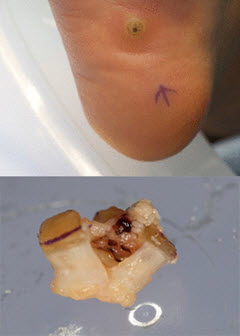(BMJ)—A 6-mo girl born at 32wk of gestation presented w/ a rash, irritability, and poor weight gain x2mo. She had hx of intrauterine growth restriction due to placental insufficiency and was exclusively breastfed. A recent course of mild topical corticosteroid failed to improve the rash. Exam: scaly, red plaques around eyes, nose, mouth, and ears. What is the dx?

|
Atopic dermatitis
|
|
Impetigo
|
|
Acrodermatitis enteropathica
|
|
Zinc deficiency
|
|
Langerhans cell histiocytosis
|
(BMJ)—On arrival to the U.K., a 2-yo girl from Brazil presented w/ a 1-day hx of a painful, itchy nodule on the sole of her R foot. After 7 days, it had grown and become more tender. Exam: 7x7-mm nodule w/ central black punctum. What is the dx?

|
Plantar verruca
|
|
Dermatobia hominis
|
|
Tungiasis
|
|
Fire ant bite
|
|
Cutaneous larva migrans
|
